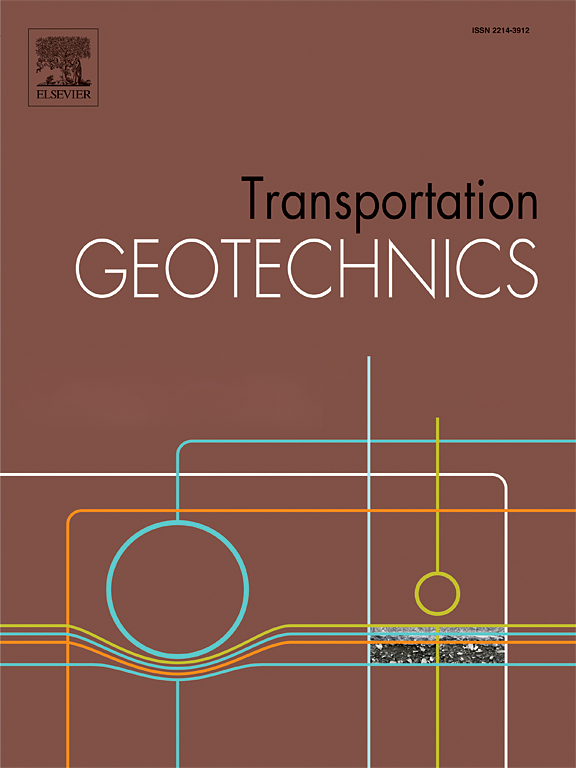钻孔定向对寒区红砂岩力学退化和微观结构演化的重要控制作用
IF 4.9
2区 工程技术
Q1 ENGINEERING, CIVIL
引用次数: 0
摘要
在高海拔寒冷地区,极端低温和频繁的冻融循环严重影响隧道围岩的稳定性。这些条件有利于裂纹扩展,降低岩石强度,加速其微观结构的逐步退化,最终加剧破坏过程。利用三轴压缩试验和核磁共振(NMR)分析,综合评价了不同旋回下孔眼方位对红砂岩物理、力学和微观特征的影响。结果表明,温度波动显著加速了红砂岩的物理劣化,表现为质量和波速逐渐减小,体积逐渐增大。冻融循环对红砂岩的弹性模量、黏聚力、内摩擦角、抗压强度等力学性能影响较大。钻孔的方向是影响退化程度的关键因素,与纵向钻孔或完整样品相比,含有轴向钻孔的样品表现出更大的强度降低。温度变化和围压之间的相互作用使岩石的破坏机制变得复杂。核磁共振分析表明,冻融过程扩大了微孔和介孔,增强了孔隙连通性,加速了微裂纹的扩展,最终破坏了岩石的结构完整性。能量演化分析强调,低围压和钻孔的存在增加了能量耗散,降低了总能量储存,突出了钻孔定向和冻融循环在驱动能量损失和结构退化方面的协同作用。本文章由计算机程序翻译,如有差异,请以英文原文为准。
Critical Role of Borehole Orientation in Governing the Mechanical Degradation and Microstructural Evolution of Red Sandstone in Cold Regions
The stability of tunnel-surrounding rock in high-altitude and cold regions is severely affected by extreme low temperatures and frequent freeze–thaw cycles. These conditions facilitate the expansion of cracks, reduce rock strength, and accelerate the progressive degradation of its microstructure, ultimately intensifying the failure process. Triaxial compression tests and nuclear magnetic resonance (NMR) analysis are utilized in this study to comprehensively assess how hole orientation influences the physical, mechanical, and microscopic characteristics of red sandstone under different cycles. The results demonstrate that temperature fluctuations significantly accelerate the physical deterioration of red sandstone, as evidenced by a progressive reduction in mass and wave velocity, coupled with a gradual increase in volume. The mechanical properties of red sandstone, such as elastic modulus, cohesion, internal friction angle, and compressive strength, are significantly compromised by freeze–thaw cycles. The orientation of boreholes is a critical factor influencing the degree of deterioration, with specimens containing axial boreholes exhibiting substantially greater strength reductions compared to those with longitudinal boreholes or complete samples. The interplay between temperature variations and confining pressure introduces complexity to the failure mechanisms of the rock. NMR analysis shows that freeze–thaw processes enlarge micropores and mesopores, enhance pore connectivity, and accelerate microcrack growth, ultimately compromising the rock’s structural integrity. Energy evolution analysis highlighted that low confining pressures and the presence of boreholes increase energy dissipation and reduce total energy storage, highlighting the synergistic effect of borehole orientation and freeze–thaw cycles in driving energy loss and structural degradation.
求助全文
通过发布文献求助,成功后即可免费获取论文全文。
去求助
来源期刊

Transportation Geotechnics
Social Sciences-Transportation
CiteScore
8.10
自引率
11.30%
发文量
194
审稿时长
51 days
期刊介绍:
Transportation Geotechnics is a journal dedicated to publishing high-quality, theoretical, and applied papers that cover all facets of geotechnics for transportation infrastructure such as roads, highways, railways, underground railways, airfields, and waterways. The journal places a special emphasis on case studies that present original work relevant to the sustainable construction of transportation infrastructure. The scope of topics it addresses includes the geotechnical properties of geomaterials for sustainable and rational design and construction, the behavior of compacted and stabilized geomaterials, the use of geosynthetics and reinforcement in constructed layers and interlayers, ground improvement and slope stability for transportation infrastructures, compaction technology and management, maintenance technology, the impact of climate, embankments for highways and high-speed trains, transition zones, dredging, underwater geotechnics for infrastructure purposes, and the modeling of multi-layered structures and supporting ground under dynamic and repeated loads.
 求助内容:
求助内容: 应助结果提醒方式:
应助结果提醒方式:


